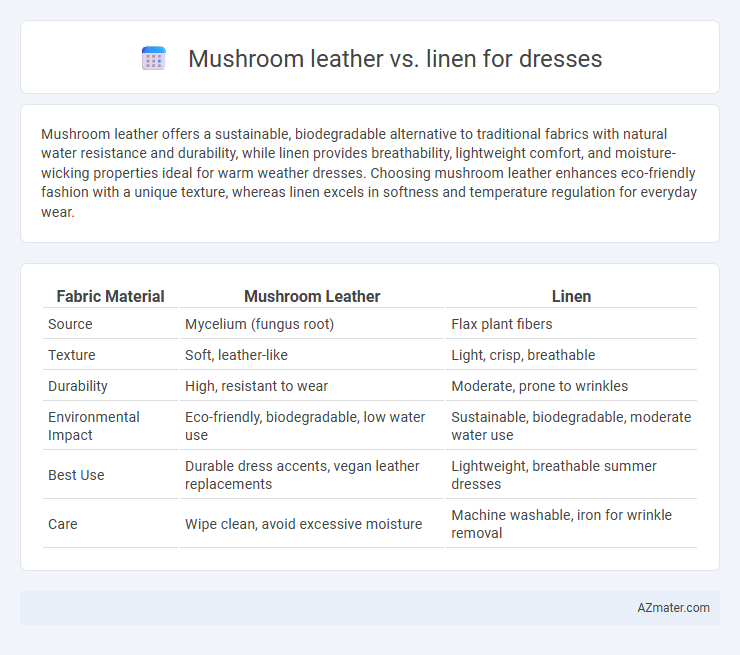Mushroom leather offers a sustainable, biodegradable alternative to traditional fabrics with natural water resistance and durability, while linen provides breathability, lightweight comfort, and moisture-wicking properties ideal for warm weather dresses. Choosing mushroom leather enhances eco-friendly fashion with a unique texture, whereas linen excels in softness and temperature regulation for everyday wear.
Table of Comparison
| Fabric Material | Mushroom Leather | Linen |
|---|---|---|
| Source | Mycelium (fungus root) | Flax plant fibers |
| Texture | Soft, leather-like | Light, crisp, breathable |
| Durability | High, resistant to wear | Moderate, prone to wrinkles |
| Environmental Impact | Eco-friendly, biodegradable, low water use | Sustainable, biodegradable, moderate water use |
| Best Use | Durable dress accents, vegan leather replacements | Lightweight, breathable summer dresses |
| Care | Wipe clean, avoid excessive moisture | Machine washable, iron for wrinkle removal |
Introduction to Sustainable Fabrics
Mushroom leather and linen represent innovative and eco-friendly alternatives in sustainable fashion, offering biodegradable and renewable materials that reduce environmental impact. Mushroom leather, derived from mycelium, mimics traditional leather without animal harm or excessive resource use, while linen, made from flax fibers, is celebrated for its durability, breathability, and low water requirements during cultivation. Both fabrics contribute to sustainable dressmaking by promoting circular fashion practices and minimizing the carbon footprint associated with conventional textile production.
What is Mushroom Leather?
Mushroom leather is an innovative, sustainable material derived from the mycelium--the root structure of mushrooms--offering a vegan alternative to animal leather with a soft texture and durability suitable for clothing. Unlike linen, which is made from flax fibers and known for its breathability and natural feel, mushroom leather provides enhanced flexibility and water resistance, making it ideal for dress applications requiring both comfort and resilience. Its eco-friendly production uses fewer resources and generates less waste, positioning mushroom leather as a cutting-edge choice in sustainable fashion materials.
What is Linen?
Linen is a natural textile made from the fibers of the flax plant, renowned for its breathability, durability, and moisture-wicking properties, making it ideal for summer dresses. Compared to mushroom leather, which is a sustainable alternative derived from mycelium, linen offers a lightweight, flexible, and hypoallergenic fabric option favored for comfort and classic aesthetics in dressmaking. Its natural texture and eco-friendly cultivation process provide a renewable choice, while mushroom leather stands out for vegan leather applications that blend innovation with sustainability.
Environmental Impact Comparison
Mushroom leather, made from mycelium, offers a sustainable alternative to traditional textiles by requiring significantly less water and land compared to linen production. Linen cultivation involves extensive land use and pesticide application, contributing to soil degradation and higher carbon emissions. The biodegradability and low resource input of mushroom leather present a lower environmental footprint, making it an eco-friendly choice for dress materials.
Durability and Longevity
Mushroom leather exhibits superior durability compared to linen, resisting wear and tear with its dense mycelium structure that can endure frequent use without significant degradation. Linen, while breathable and lightweight, tends to weaken and fray over time, especially with repeated washing and exposure to sunlight. For long-lasting dresses, mushroom leather offers enhanced longevity due to its robust, water-resistant properties and natural resilience against abrasion.
Comfort and Breathability
Mushroom leather offers a soft, flexible texture that adapts well to body movements, enhancing comfort during extended wear, while its natural mycelium structure promotes moderate breathability. Linen, derived from flax fibers, excels in breathability due to its loose weave and moisture-wicking properties, making it ideal for hot climates and reducing sweat accumulation. When choosing between the two for dressmaking, linen provides superior air circulation and cooling comfort, whereas mushroom leather delivers a more structured fit with adequate ventilation for moderate temperatures.
Aesthetic Qualities and Style
Mushroom leather offers a smooth, supple texture with a subtle, organic grain that provides a modern, eco-conscious appeal perfect for sleek, contemporary dress designs. Linen features a natural, breathable fabric with a slightly coarse weave, giving dresses a rustic, relaxed elegance and timeless charm. Both materials enhance style uniquely: mushroom leather suits structured, minimalist silhouettes, while linen complements flowing, casual forms.
Maintenance and Care
Mushroom leather requires gentle cleaning with a damp cloth and avoids harsh chemicals to maintain its durability and texture, while linen demands frequent washing to prevent wrinkles and stains but benefits from its natural breathability and strength. Mushroom leather resists moisture and odors better than linen, reducing the need for frequent cleaning. Linen's natural fibers may shrink or fade if not cared for properly, necessitating careful laundering and ironing to retain its appearance.
Price and Market Availability
Mushroom leather, derived from mycelium, is priced higher due to its innovative production methods and limited supply in the fashion industry compared to traditional linen, which remains more affordable and widely available. Linen, made from flax fibers, boasts established global cultivation and processing networks, ensuring consistent market presence and competitive pricing for dressmaking. The growing demand for sustainable materials drives interest in mushroom leather, but linen's market dominance maintains its position as the cost-effective choice.
Which is Better for Dresses?
Mushroom leather offers a sustainable and vegan-friendly alternative to traditional fabrics, providing durability and a unique texture ideal for contemporary dress designs. Linen, renowned for its breathability and natural moisture-wicking properties, excels in comfort and is preferred for lightweight, summer dresses. The choice between mushroom leather and linen depends on the desired aesthetic, environmental impact, and functionality, with mushroom leather suited for structured, eco-conscious fashion and linen favored for casual, breathable wear.

Infographic: Mushroom leather vs Linen for Dress
 azmater.com
azmater.com